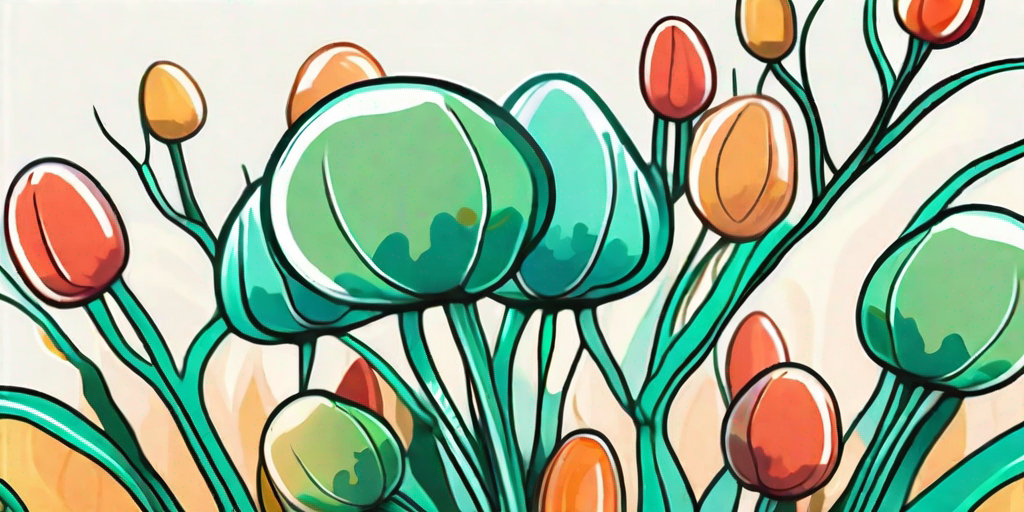
If you're a fan of jelly beans and gardening, then you're in for a treat! Imagine a world where you can grow your own sweet delights right in your backyard. No, we're not talking about the magical world of Willy Wonka, but the very real and exciting world of horticulture. Welcome to the Jelly Bean Plant guide, where we'll show you how to grow your own sugary snacks. Let's dive in, shall we?
Understanding the Jelly Bean Plant
Before we get our hands dirty, let's clear up a common misconception. The Jelly Bean Plant, scientifically known as Sedum rubrotinctum, doesn't actually produce jelly beans. Shocking, right? It's a succulent plant known for its bean-like leaves that resemble our beloved candies. However, don't let this deter you. The Jelly Bean Plant is a delightful addition to any garden and can bring a touch of whimsy to your green space.
Native to Mexico, the Jelly Bean Plant is a hardy succulent that thrives in warm, dry climates. It's an excellent choice for beginners as it requires minimal care and can tolerate a bit of neglect. Its leaves, which range from green to red, are filled with water-storing tissues, allowing it to survive in arid conditions. Now that we've got the basics covered, let's move on to the fun part - growing your own Jelly Bean Plant.
Planting Your Jelly Bean Plant
First things first, you'll need to get your hands on a Jelly Bean Plant. You can either purchase a young plant from a nursery or propagate one from a leaf or stem cutting. If you're feeling adventurous, go for the latter. It's a rewarding process that allows you to witness the magic of plant growth firsthand.
Once you have your plant or cutting, it's time to get planting. Choose a well-draining potting mix, preferably one designed for succulents, and a pot with drainage holes. Plant your Jelly Bean Plant in the pot, ensuring the roots (or the end of the cutting) are well covered with soil. Place the pot in a sunny spot, and you're good to go.
Watering and Feeding Your Plant
When it comes to watering your Jelly Bean Plant, less is more. Overwatering is a common cause of plant death, especially for succulents. Water your plant thoroughly, then allow the soil to dry out completely before watering again. In the cooler months, you may only need to water your plant once a month.
As for feeding, a slow-release fertilizer applied in the spring and summer should do the trick. Remember, succulents are adapted to thrive in nutrient-poor soils, so don't overdo it with the fertilizer.
Pruning and Propagating Your Plant
Pruning your Jelly Bean Plant is a piece of cake. Simply pinch off any leggy stems or dead leaves as needed to maintain its bushy appearance. The removed parts can be used for propagation. Just let the cuttings dry for a few days, then plant them in a potting mix. In a few weeks, you'll have a new Jelly Bean Plant to add to your collection.
Now that we've covered the basics of Jelly Bean Plant care, let's address some frequently asked questions.
Frequently Asked Questions
Why are the leaves on my Jelly Bean Plant falling off?
Don't panic! Leaf drop is a common issue with succulents and is often a sign of overwatering. Cut back on the water and ensure your plant is in a well-draining potting mix. If the problem persists, it may be due to a lack of light or temperature fluctuations.
Can I grow a Jelly Bean Plant outdoors?
Absolutely! Jelly Bean Plants can thrive outdoors in USDA hardiness zones 9 to 11. They love the sun and can tolerate drought, making them an excellent choice for rock gardens or xeriscaping. Just remember to bring them indoors if the temperature drops below freezing.
Fun Facts About the Jelly Bean Plant
Now that we've covered the serious stuff, let's delve into some fun facts about the Jelly Bean Plant. Did you know that the plant's leaves can turn red when exposed to full sun? This is a protective mechanism to prevent sunburn. So, if your Jelly Bean Plant is looking a bit red, don't worry - it's just working on its tan.
Another fun fact is that the Jelly Bean Plant can produce bright yellow, star-shaped flowers in the spring and summer. These flowers can attract pollinators, adding a buzz of activity to your garden. Who knew that a plant named after a candy could be so fascinating?
Conclusion
And there you have it - your comprehensive guide to growing and caring for a Jelly Bean Plant. Whether you're a seasoned gardener or a newbie, this delightful succulent is sure to bring a touch of sweetness to your green space. So, what are you waiting for? It's time to roll up your sleeves and start growing your own Jelly Bean Plant. Happy gardening!















